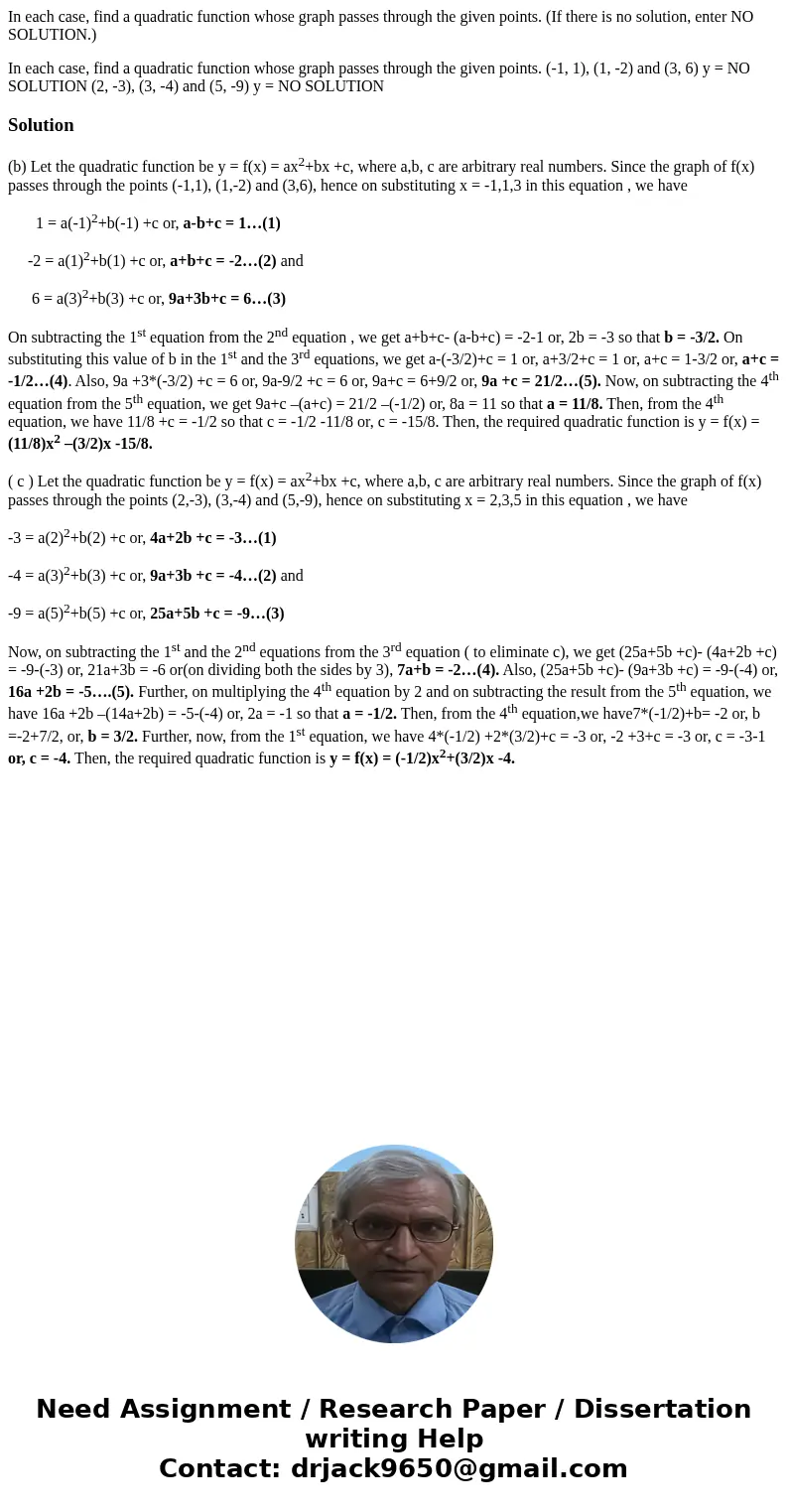In each case find a quadratic function whose graph passes th
In each case, find a quadratic function whose graph passes through the given points. (If there is no solution, enter NO SOLUTION.)
In each case, find a quadratic function whose graph passes through the given points. (-1, 1), (1, -2) and (3, 6) y = NO SOLUTION (2, -3), (3, -4) and (5, -9) y = NO SOLUTIONSolution
(b) Let the quadratic function be y = f(x) = ax2+bx +c, where a,b, c are arbitrary real numbers. Since the graph of f(x) passes through the points (-1,1), (1,-2) and (3,6), hence on substituting x = -1,1,3 in this equation , we have
1 = a(-1)2+b(-1) +c or, a-b+c = 1…(1)
-2 = a(1)2+b(1) +c or, a+b+c = -2…(2) and
6 = a(3)2+b(3) +c or, 9a+3b+c = 6…(3)
On subtracting the 1st equation from the 2nd equation , we get a+b+c- (a-b+c) = -2-1 or, 2b = -3 so that b = -3/2. On substituting this value of b in the 1st and the 3rd equations, we get a-(-3/2)+c = 1 or, a+3/2+c = 1 or, a+c = 1-3/2 or, a+c = -1/2…(4). Also, 9a +3*(-3/2) +c = 6 or, 9a-9/2 +c = 6 or, 9a+c = 6+9/2 or, 9a +c = 21/2…(5). Now, on subtracting the 4th equation from the 5th equation, we get 9a+c –(a+c) = 21/2 –(-1/2) or, 8a = 11 so that a = 11/8. Then, from the 4th equation, we have 11/8 +c = -1/2 so that c = -1/2 -11/8 or, c = -15/8. Then, the required quadratic function is y = f(x) = (11/8)x2 –(3/2)x -15/8.
( c ) Let the quadratic function be y = f(x) = ax2+bx +c, where a,b, c are arbitrary real numbers. Since the graph of f(x) passes through the points (2,-3), (3,-4) and (5,-9), hence on substituting x = 2,3,5 in this equation , we have
-3 = a(2)2+b(2) +c or, 4a+2b +c = -3…(1)
-4 = a(3)2+b(3) +c or, 9a+3b +c = -4…(2) and
-9 = a(5)2+b(5) +c or, 25a+5b +c = -9…(3)
Now, on subtracting the 1st and the 2nd equations from the 3rd equation ( to eliminate c), we get (25a+5b +c)- (4a+2b +c) = -9-(-3) or, 21a+3b = -6 or(on dividing both the sides by 3), 7a+b = -2…(4). Also, (25a+5b +c)- (9a+3b +c) = -9-(-4) or, 16a +2b = -5….(5). Further, on multiplying the 4th equation by 2 and on subtracting the result from the 5th equation, we have 16a +2b –(14a+2b) = -5-(-4) or, 2a = -1 so that a = -1/2. Then, from the 4th equation,we have7*(-1/2)+b= -2 or, b =-2+7/2, or, b = 3/2. Further, now, from the 1st equation, we have 4*(-1/2) +2*(3/2)+c = -3 or, -2 +3+c = -3 or, c = -3-1 or, c = -4. Then, the required quadratic function is y = f(x) = (-1/2)x2+(3/2)x -4.

 Homework Sourse
Homework Sourse